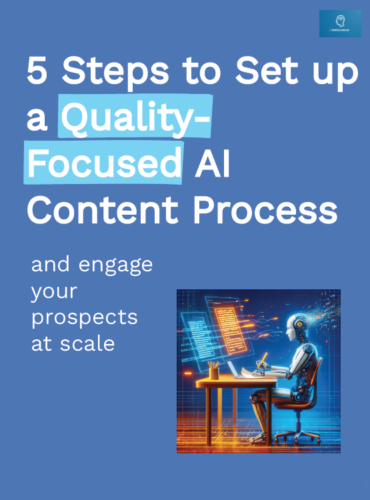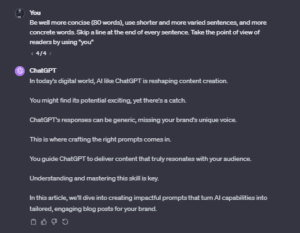During my emerging career, I’ve helped a fair share of tech brands sell their products and consulting services.
And there’s one mistake I’ve often seen: assuming technical writing should favor accuracy over accessibility. Let’s say it straight away: this makes sense for technical documentation but less for marketing content.
In fact, tech-savvy audiences enjoy attention-grabbing writing just as much as anyone else.
Here are 6 best practices that will help you tell compelling stories about high-tech products and services.
#1 Adding stakes to your intro
If there’s one thing that sells your content it’s your introduction. And tech content is no exception to the rules. You need to make your new piece of technical material worthwhile to read.
What will make sure you grab the attention of your savvy readers? Show that your subject is at the heart of the current challenges of their industry.
Your technical readers want to know they have the latest news about the most trending technology in their hands. They need to know that you’re an insider and that you have something that they don’t know -and staying ahead of their competitors is really important for them.
You can report on recent developments about a major company in the market, share some startling statistics about the issue, or simply point out an industry-wide problem.
For my part, I always make sure to recall an everyday situation that speaks to them. For example, I describe them as losing time in CRM note-taking when introducing a new way of handling customer data. This intuitively compels them to read more.
#2 Engaging your readers personally
Imagine someone addressing you by your first name: there’s no language more powerful.
So why not substitute your impersonal writing for personal pronouns and phrasing? That means turning your passive voice into you-driven and active verb phrases.
Instead of saying “There are many challenges in implementing data analytics in construction operations”, you can say “You might face many struggles when seeking to implement data analytics in your construction operation”. You’ll already feel the difference.
Making your writing more relatable also involves putting yourself in your audience’s shoes. You need to understand what your readers feel about your subjects- their pain points, their goals, and their challenges.
Does this subject trigger in their mind frustrating memories? The hope of new and exciting innovations? Confusion about a novel and complex notion they heard about? In each case, you won’t take the same angle to your story.
When I’m writing about robots, my focus is always on plant managers: their environment -the shop floor- and their daily challenges -keeping their production line up and running. That way, they know I’m always talking about them, and not just the product.
#3 Telling the story of your tech
Tech is often seen as a dry and unpassionate subject. That’s unfair.
Tech companies can leverage one of their most exciting and precious marketing resource: their history.
Created by passionate innovators, each new tech product defines its own “mythology”. From the software, hardware, or robotics industry, any tech insider can tell you how a product has been designed and marketed. So you might as well take your technical readers back in time and give them a small retrospective of the subject.
To enrich your storytelling, you can make innovators, products, and companies the heroes of your stories. You might elaborate extensively on their purpose, describe their past challenges, and how they have overcome them. Of course, you might not make it all of your article, but it will keep your readers engaged.
To get back to robotics, manufacturers have a strong attachment to industrial history. So I’ve often added sections about the history of robot brands & manufacturers: who designed the robot model, what purpose the designer had in mind, and how it has been designed. Hearing these tidbits is pure delight for industrial insiders.
#4 Being helpful and exhaustive
This one seems obvious. After all your tech readers are coming for your help, right? They want to get their questions answered.
Yet, pieces of tech content too often look like a one-sided sales pitch or product demonstration. This doesn’t help you win and retain customers.
To reap all the benefits of content marketing, you need to provide genuinely helpful information, insight, and guidance. You need to make your readers feel that you have their best interest at heart, that you are there to help them and not just sell to them.
So go for it, and give your readers everything to resolve their problems. That means covering extensively the subject -the “what”, “why”, “how”, “when”, and “who”. Tell them what the subject is, why this subject is really important to consider, how they can achieve/resolve/improve/ it, who and when to bring it up.
The “how” part is especially important. You might provide a step-by-step method, get into the details of each step, and give real solutions through personal examples. In the extreme, you might mention other companies’ solutions, even your competitors’. Because if your company is comfortable with its product’s selling points, why not?
Some might object that your readers don’t have time to scroll down to find the answer they need. But every reader is different, and as long as they want their questions answered, they will each search for the right information.
The most important thing to keep in mind is that as long you give your readers valuable insights, they’ll trust your company more, and be even more likely to show interest.
#5 Refining your writing style
The golden rules of writing also apply to technical content. Technical readers crave as much as anyone short, easy-to-understand, and straightforward texts. They also despise unnecessarily lengthy and convoluted writing pieces.
So you want to craft sentences that are sharp and appealing to the eye. Here are some editing recommendations :
- Favoring active verbs and action-oriented phrases.
- Shortening your sentences by removing unnecessary words or using shorter expressions (from “a solution powered by AI” to “an AI-powered solution”).
- Cutting sentences that have more than three propositions.
- Switching between long and short sentences to keep the eye engaged.
- Employing familiar words or expert vocabulary when it is widely recognized or by explaining it succinctly.
By following these best practices, you’ll ensure to keep your readers hooked throughout the page.
#6 Fitting your pitch into your story
In the end, you do want to sell your product in your article- but not in any way. What’s most important is to make your pitch a natural part of your article. You want to make it feel like your marketing message follows logically from your explanation.
To achieve that, you can talk about your product and service in a way that answers the question at hand. You can highlight the features or specificities of your solution that best resolve the issue talked about.
To reinforce your message, you can add storytelling elements to your pitch. You can talk about how the team has always been aware of this particular issue and how they have found a new to address it.
For example, when I was selling subtitling software, I always came back to the origin story of the company:
“Once upon a time, a team of video creators realized how tedious adding subtitles to a video is. Since they wanted to save their time for more precious creative endeavors, they sought to build a tool that makes the life of video creators easier. The teammates have spent years designing features that resolve recurring problems in the subtitling process (audio-to-text synching, text proofreading, or translation). They have struggled to make it work together, and that’s why now they can provide you with a solution that makes subtitling as easy as ever.”
As you can see, the best way to sell is to show that you are true to your cause, but also true to your readers.





